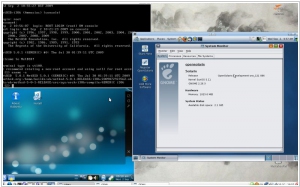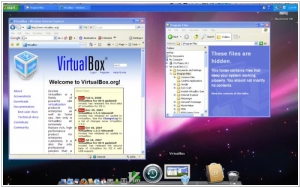KVM vs VirtualBox
May 27, 2023 | Author: Michael Stromann
16

KVM (for Kernel-based Virtual Machine) is a full virtualization solution for Linux on x86 hardware containing virtualization extensions (Intel VT or AMD-V). It consists of a loadable kernel module, kvm.ko, that provides the core virtualization infrastructure and a processor specific module, kvm-intel.ko or kvm-amd.ko. KVM also requires a modified QEMU although work is underway to get the required changes upstream.
7

Oracle VirtualBox is a powerful virtualization product for enterprise as well as home use. Not only is VirtualBox an extremely feature rich, high performance product for enterprise customers, it is also the only professional solution that is freely available as Open Source Software under the terms of the GNU General Public License (GPL) version 2. See "About VirtualBox" for an introduction.
KVM (Kernel-based Virtual Machine) and VirtualBox are both popular virtualization platforms, but they have some key differences in terms of architecture, performance, and feature set.
1. Architecture: KVM is a hypervisor built into the Linux kernel, which means it leverages the existing Linux infrastructure for hardware virtualization. On the other hand, VirtualBox is a type 2 hypervisor that runs on top of the host operating system.
2. Performance: KVM generally offers better performance compared to VirtualBox, especially for workloads that require high-performance computing or I/O-intensive operations. Since KVM is integrated with the Linux kernel, it can take advantage of hardware acceleration features, such as Intel VT-x or AMD-V, for improved performance.
3. Scalability: KVM is designed to scale well and handle large numbers of virtual machines (VMs). It supports a greater number of concurrent VMs and can efficiently utilize hardware resources. VirtualBox, while capable of running multiple VMs, may face performance limitations when dealing with a large number of VMs or demanding workloads.
4. Management and Features: VirtualBox provides a user-friendly graphical interface and is known for its ease of use, making it suitable for desktop virtualization and development environments. It offers a rich set of features, including snapshot support, USB device passthrough, and seamless mode. KVM, on the other hand, is often managed through command-line tools or higher-level management frameworks like libvirt. It offers more advanced features, such as live migration, storage management options, and better integration with Linux-based tools and technologies.
5. Host Operating System Support: VirtualBox supports a wide range of host operating systems, including Windows, macOS, and various Linux distributions. KVM, being a kernel-level hypervisor, is typically used on Linux-based systems and requires hardware virtualization support from the host CPU.
See also: Top 10 Virtualization platforms
1. Architecture: KVM is a hypervisor built into the Linux kernel, which means it leverages the existing Linux infrastructure for hardware virtualization. On the other hand, VirtualBox is a type 2 hypervisor that runs on top of the host operating system.
2. Performance: KVM generally offers better performance compared to VirtualBox, especially for workloads that require high-performance computing or I/O-intensive operations. Since KVM is integrated with the Linux kernel, it can take advantage of hardware acceleration features, such as Intel VT-x or AMD-V, for improved performance.
3. Scalability: KVM is designed to scale well and handle large numbers of virtual machines (VMs). It supports a greater number of concurrent VMs and can efficiently utilize hardware resources. VirtualBox, while capable of running multiple VMs, may face performance limitations when dealing with a large number of VMs or demanding workloads.
4. Management and Features: VirtualBox provides a user-friendly graphical interface and is known for its ease of use, making it suitable for desktop virtualization and development environments. It offers a rich set of features, including snapshot support, USB device passthrough, and seamless mode. KVM, on the other hand, is often managed through command-line tools or higher-level management frameworks like libvirt. It offers more advanced features, such as live migration, storage management options, and better integration with Linux-based tools and technologies.
5. Host Operating System Support: VirtualBox supports a wide range of host operating systems, including Windows, macOS, and various Linux distributions. KVM, being a kernel-level hypervisor, is typically used on Linux-based systems and requires hardware virtualization support from the host CPU.
See also: Top 10 Virtualization platforms


